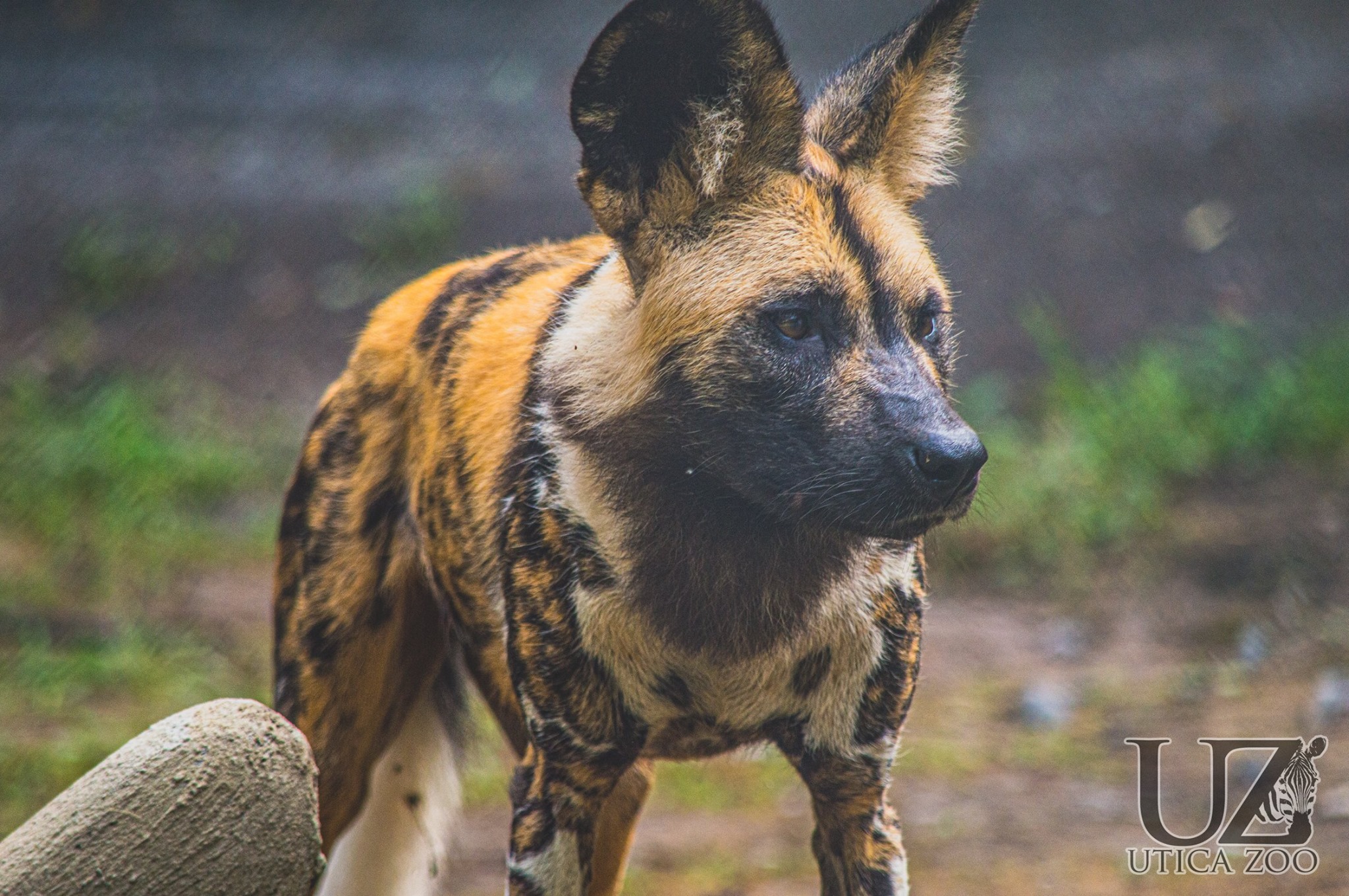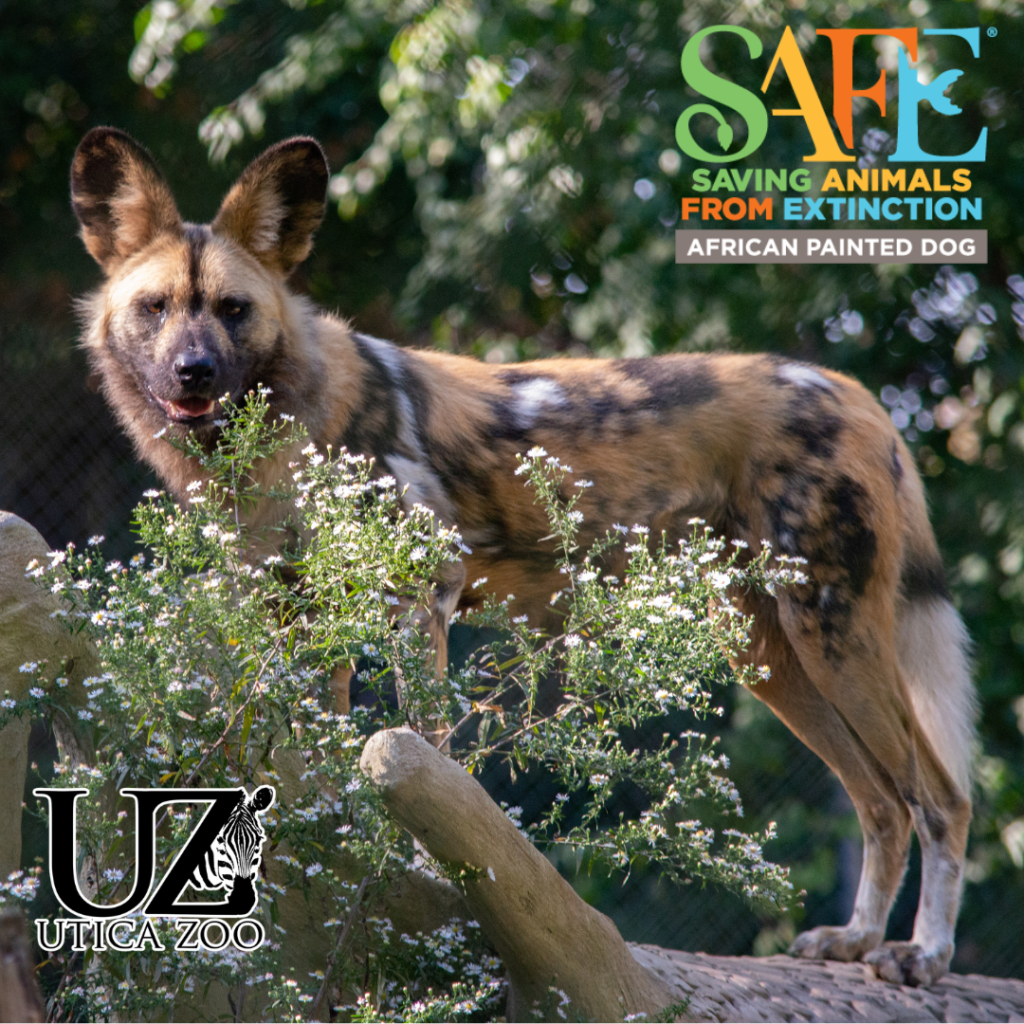African Painted Dog

Basic Information:
Scientific Name: Lycaon pictus
Habitat: While African Painted Dogs used to be more common, today the species is limited to small packs scattered across savannas and arid regions in Sub-Saharan Africa. Today, the largest populations can be found in Botswana, Zimbabwe, Namibia, Zambia, Tanzania, and Mozambique.
Diet: African Painted Dogs are predators and they typically hunt kudu, gazelle, impala, bushbuck, and wildebeest.
Size: 2 to 3 feet tall / 2.3 to 4 feet long
Weight: 40 to 75 pounds
Lifespan: 10.1 years according to AZA Species Survival Statistics
Distribution Map:
I.U.C.N. Conservation Status:

What does this mean?
Endangered – a species determined by the International Union for Conservation of Nature (I.U.C.N.) to possess a very high risk of extinction as a result of rapid population declines of 50 to more than 70 percent over the previous 10 years (or three generations), a current population size of fewer than 250 individuals, or other factors.
African Painted Dog SAFE Program:

Saving Animals from Extinction (SAFE) is a program with the goal of using the collective expertise within AZA-accredited zoos and aquariums to save threatened species.
Painted Dogs were once found all over the African continent, but today they only encompass 9% of their historic range. While it was once common for these animals to have packs consisting of 20 or more dogs, today this is far less common. Like with a lot of threatened species, this decline is directly related to human expansion. As populations began spreading across Africa, more natural habitats have been destroyed. Combine this with local farmers hunting painted dogs out of fear for their livestock as well as diseases spread from domestic dogs and poaching, painted dog populations have been decimated. Today, there is estimated to be fewer than 7,000 painted dogs left in the wild.
So how can you help? Step one is merely appreciating the painted dog species. The best way to do this is to visit zoos – like the Utica Zoo – that have this unique breed of canine and see them for yourself. From there, help raise public awareness by sharing what you’ve learned with the people you know. And finally, help painted dog populations by donating to the organizations that seek to help them directly such as Painted Dog Conservation. And through all of this, we can work together to help save this remarkable species!
Want to learn even more and see ways that you can support Painted Dog populations? Click the link below!
Our African Painted Dogs:
Charlie (Female) – Born November 20th, 2018
Ada (Female) – Born November 20th, 2018
Rosie (Female) – Born November 20th, 2018
About African Painted Dogs:
Also known as the African Wild dog, Cape Hunting Dog, or – simply – Painted Dog, African Painted Dogs are an endangered canine native to Botswana, Zimbabwe, Namibia, Zambia, Tanzania, and Mozambique. They hunt in packs consisting of between 6 and 20 (or more) dogs. Packs on the larger side are capable of hunting more efficiently and successfully, can prey on larger species, and have a better chance of protecting their kills from scavengers. This decreases the quantity of required hunts, which reduces the pack’s energetic costs and risk, increasing overall fitness. Painted dogs hunt cooperatively in a relay type form taking turns running after the prey. Painted dogs depend on their ability to run for a long time without getting tired so they can outlast their prey. They can run up to 37 miles per hour for up to 3 miles which allows them to catch prey with ease. All of this makes painted dogs one of the most successful hunters in all of Africa, catching prey 70 to 90 percent of the time (lions are only successful 30 to 40 percent of the time). Unfortunately, due to their declining population, it has become more and more rare to find large packs. Their primary threats include human expansion, being hunted by farmers fearing – inaccurately – for their livestock, and getting caught in traps left by poachers desperate for a quick profit through “bushmeat” OR by traps intended for big game animals (which coincidentally also happen to be Painted Dog prey).
Did You Know?!
- These long-legged canines have only four toes per foot, unlike other dogs which have five toes on their forefeet.
- A painted dog’s large, rounded ears give them excellent hearing and help to keep them cool in hot climates.
- Painted dog’s coat patterning is unique to each individual dog. But, coat patterns are recognizably similar in close relatives.
- Painted dogs are crepuscular meaning that they rest during the day and become active in the early morning and evening.
- Painted dogs’ vocal repertoire is one of the most complex in Canidae (dog species) with some sounds unique to the species.
- In a painted dog pack, there is one dominant male and female called the alpha pair. The most reliable way to recognize them is by observing which members of the pack urine-mark as this task is the prerogative of the dominant male and female. Typically only the female alpha will breed, but subordinate females (betas) will sometimes have litters of their own.
- A painted dog’s litter has – on average – 10 to 12 pups, however they can have up to 21. This is the largest litter of any dog species.
- Painted dog pack members get along very well most of the time. Food sharing is a critical part of pack life. The adult dogs eat and then regurgitate the meat for injured or ill pack members and youngsters.
- With most social mammals, the females stay with the group and raise their young while the males leave to start new groups. Painted dogs do the opposite. The females are the ones to leave the pack, sometimes as a group of sisters, to join a new pack when they are about three years old. Males generally remain in the pack they were born into.
- Given the social nature of painted dogs, a disease such as rabies can permeate an entire group through just one dog, and wipe out a whole pack. To help combat this, several conservation organizations have programs that involve vaccinating as many domestic dogs as possible in the villages that surround areas where painted dogs are present.

